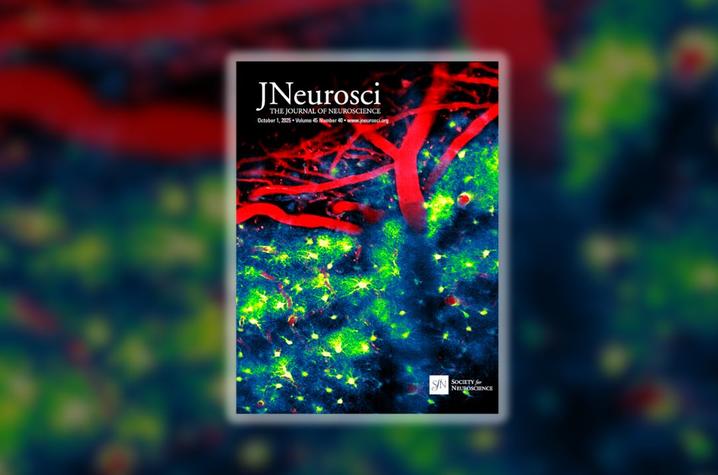UK researchers uncover key brain cell communication breakdown in Alzheimer’s disease

LEXINGTON, Ky. (Oct. 9, 2025) — A team of researchers at the University of Kentucky Sanders-Brown Center on Aging now have a better understanding of how the brain’s support cells communicate with blood vessels — a process that goes awry in Alzheimer’s disease.
The study was recently featured on the cover of The Journal of Neuroscience. The cover image was taken by Blaine Weiss, first author on the paper and a graduate student in the Department of Pharmacology and Nutritional Sciences in the UK College of Medicine.
The team revealed a critical weak link that may help explain why and how the brain’s energy supply short-circuits in people with Alzheimer’s and related dementias.
“This study pinpoints a crucial breakdown in communication between brain cells and blood vessels in Alzheimer’s,” said Chris Norris, Ph.D., professor of pharmacology and nutritional sciences, associate director at Sanders-Brown and senior author of the study. “It opens the door to new ways of thinking about astrocyte-centric therapies to help restore normal blood flow and metabolic health in the aging brain.”
Norris and the team looked at astrocytes — star-shaped support cells that help the brain’s blood vessels deliver energy where it’s needed and that maintain healthy communication between nerve cells. In Alzheimer’s, astrocytes become reactive — changing how they function in ways that are still not fully understood.
This study is part of Norris’ larger project called Strategies for Targeting Astrocyte Reactivity in Alzheimer’s Disease and Related Dementias (STAR-ADRD), which is funded by a $20.5 million grant from the National Institute on Aging (NIA) of the National Institutes of Health (NIH). This study was also supported by another $1.8 million NIA grant.
Researchers used advanced imaging in a mouse model, combined with a custom analysis program (designed by Weiss), to watch and measure astrocyte activity around blood vessels in real time. Their findings show that, in mice with Alzheimer’s-like changes, astrocytes show hyper-frequent activity that is “out of sync” with each other and with blood vessel activity.
“This means the brain may not get energy when and where it’s needed, contributing to problems with thinking and memory,” said Norris.
Norris’ team included experts from Sanders-Brown, the Department of Pharmacology and Nutritional Sciences, Department of Biostatistics, Department of Behavioral Science and Division of Neuropathology at UK along with researchers from the Stark Neuroscience Research Institute in Indianapolis.
Research reported in this publication was supported by the National Institute on Aging of the National Institutes of Health under Award Numbers P01AG078116 and R01AG027297. The content is solely the responsibility of the authors and does not necessarily represent the official views of the National Institutes of Health.
As the state’s flagship, land-grant institution, the University of Kentucky exists to advance the Commonwealth. We do that by preparing the next generation of leaders — placing students at the heart of everything we do — and transforming the lives of Kentuckians through education, research and creative work, service and health care. We pride ourselves on being a catalyst for breakthroughs and a force for healing, a place where ingenuity unfolds. It's all made possible by our people — visionaries, disruptors and pioneers — who make up 200 academic programs, a $476.5 million research and development enterprise and a world-class medical center, all on one campus.




